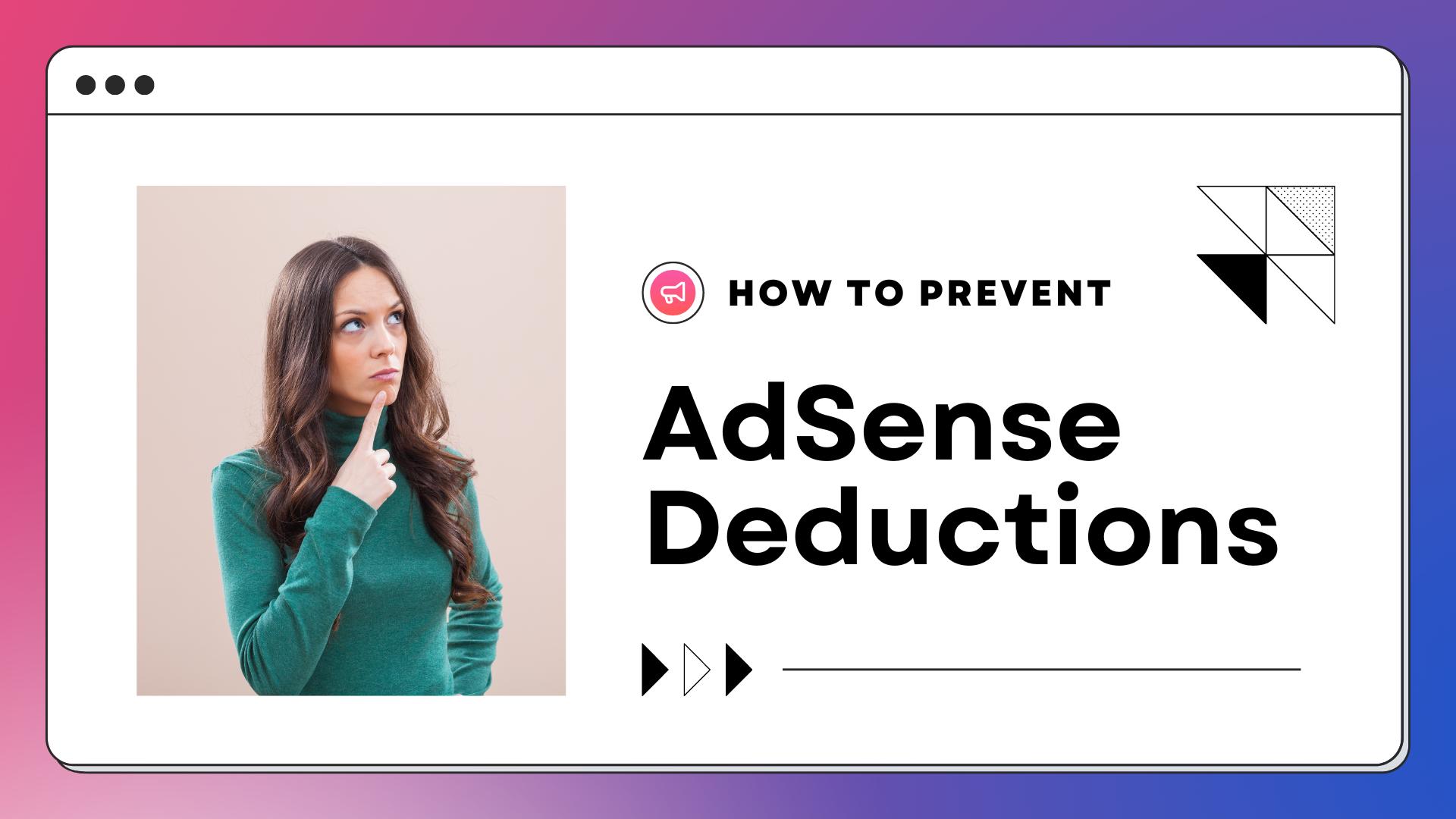
Google AdSense invalid traffic deductions: what they are and how to avoid them
When it comes to Google AdSense, one of the biggest concerns for website publishers is invalid traffic deductions. Invalid traffic is defined as any clicks or impressions that may have been generated by automated means or by someone who has no intention of interacting with the ad. This can include clicks or impressions generated by bots, click farms, or even accidental clicks. Invalid traffic can also come from people who deliberately click on ads to inflate traffic numbers or to generate income for themselves. Invalid traffic can have a significant impact on a website’s AdSense earnings, as it can result in deductions from your total revenue.
According to The Interactive Advertising Bureau (IAB), invalid traffic:
• Costs to advertisers: $4.4B
• Cost to fight: $169M
According to the other sources, the loss due to invalid traffic is $80B-120B in 2022.
Chances are, if you’ve been publishing content online for a while, you’ve had some experience with AdSense. AdSense is a program that allows website publishers to place ads on their site and earn money from clicks. Invalid traffic for AdSense is a fraud and publishers are supposed to prevent it.
However, AdSense can also deduct money from your earnings if it detects invalid traffic. Google continually upgrades the detection mechanisms of invalid traffic to proactively combat it.
In this article, we’ll discuss what invalid traffic is and how you can avoid having your earnings deducted.
What is invalid traffic?
IVT is defined as “impressions or clicks that may artificially inflate an ad publisher’s revenue.” Here is a detailed article on invalid traffic.
In other words, IVT is when someone clicks on an ad or impressions on an ad that is not supposed to be there.
This can happen for a variety of reasons, but the most common ones are:
- Bot traffic
- Click farms
- Fraudulent activity
- Accidental clicks
- Invalid impressions
- Layout and CSS shift problems, placement of ads near call to action buttons.
How does Google detect Invalid Traffic?
Google uses a variety of signals to detect IVT.
Some of these signals are:
- The source of the traffic
- The location of the traffic
- The device used to generate the traffic
- The time of day the traffic was generated
- The patterns of the traffic
The consequences of Invalid Traffic: If Google detects invalid traffic, they will deduct the revenue generated from that traffic from your AdSense account.
They will also send you an email notification about the deduction.
Invalid traffic is pretty common as the academic research indicates:
Along with gaining popularity of Real-Time Bidding (RTB) based programmatic advertising, the click farm based invalid traffic, which leverages massive real smartphones to carry out large-scale ad fraud campaigns, is becoming one of the major threats against online advertisement.
Source: Understanding and Detecting Mobile Ad Fraud Through the Lens of Invalid Traffic Suibin Sun, Le Yu, Xiaokuan Zhang, Minhui Xue, Ren Zhou, Haojin Zhu, Shuang Hao, Xiaodong Lin CCS ’21: Proceedings of the 2021 ACM SIGSAC Conference on Computer and Communications Security November 2021 Pages 287–303
How can I avoid Invalid Traffic deductions?
The best way to avoid IVT deductions is to create high-quality content that people actually want to read or watch.
If you’re generating traffic from sources that are known to be high in IVT, such as link farms or traffic exchanges, you’re more likely to get deductions.
You can also use Google’s Invalid Traffic detection tool to help you identify and fix any potential IVT issues on your site.
If AdSense detects invalid traffic, it will deduct money from your earnings.
Why Does AdSense Deduct Money for Invalid Traffic?
Google AdSense has a strict policy against invalid traffic because it ruins the user experience and gives advertisers a bad impression of the AdSense program. Invalid traffic also drives up costs for advertisers, which ultimately means that AdSense has to charge more to make a profit.
How can I avoid having my ad revenue deducted?
There are a few things you can do to avoid invalid traffic deductions. First, make sure that your website is well-designed and easy to navigate. This will help to ensure that people are actually interested in the content on your site and are not just clicking on ads out of curiosity. Second, use relevant keywords in your ad campaigns so that you attract the right kind of traffic. And third, monitor your traffic closely to identify any patterns of invalid traffic. If you see a sudden spike in invalid traffic, you can take steps below to block that traffic from your site.

There are a few things you can do to avoid having your earnings deducted concerning the source of traffic:
- Use a traffic source that doesn’t use bots or scripts
- Use a traffic source that uses human traffic only
- Use a traffic source that has a low rate of invalid traffic
- Use a traffic source that doesn’t allow automated programs to click on ads
- Use a traffic source that uses HTTPS
- Use a traffic source that doesn’t use pop-ups, pop-unders, or automatic redirects
- Use a traffic source that doesn’t use iframes
- Use a traffic source that doesn’t use automated software to click on ads
- Use a traffic source that doesn’t use cookies to track clicks
- Use a traffic source that doesn’t use tracker pixels
There are a few things you can do to avoid invalid traffic deductions:
- Don’t click on your own ads
This one is pretty self-explanatory. If you click on your own ads, you’re more likely to be flagged for invalid traffic.
- Be careful with your ad placements
If you’re placing your ads in places where they’re likely to be clicked on by people who are not interested in your product or service, you’re more likely to be flagged for invalid traffic.
- Monitor your click-through rate
If you notice a sudden drop in your click-through rate, it could be an indication that you’re being flagged for invalid traffic. If you notice a sudden increase in the CTR you should suspect from invalid traffic. Keep in mind that invalid traffic deductions can eb backwards months and can lead to the suspension of your AdSense account.
- Use an invalid traffic tool
If you use an invalid traffic tool, you will get most of the invalid traffic blocked.
- The following Ad unit layout issues result in AdSense paycuts:
- Solve these layout issues if any: Ad units too close to call-to-action buttons. Longer loading time of ads. Floating ad units that don’t even have a ‘minimize’ or “dismissal” option. Ad units overlaying the menu or navigation elements on the webpages. CSS and layout shifts. Native ads that are not labeled as sponsored so that users expect them to be a webpage of the same domain when they click on them.
What is an invalid traffic tool?
An invalid traffic prevention tool is a device or software that is used to detect and prevent invalid traffic on a website. Invalid traffic is defined as traffic that is not generated by a human user, such as traffic generated by bots or automated scripts. Invalid traffic can inflate a website’s traffic numbers and skew its analytical data, which can lead to incorrect conclusions about the site’s popularity or success. Invalid traffic can also place an undue burden on a website’s servers and infrastructure.
There are a variety of invalid traffic prevention tools available, including server-side tools and client-side tools. Server-side tools are typically more effective at detecting and blocking invalid traffic, as they have access to a website’s server logs. Client-side tools, on the other hand, are typically less effective, as they can only detect traffic that is routed through the user’s computer.
Invalid traffic prevention tools are important for website publishers, as they can help to ensure that traffic data is accurate and that website infrastructure is not overloaded by invalid traffic.
As a website publisher, it’s important to be aware of the potential for invalid traffic and to take steps to prevent it. Invalid traffic can skew your analytical data and lead to incorrect conclusions about your site’s popularity or success. It can also place an undue burden on your website’s servers and infrastructure.
By taking steps to prevent invalid traffic, you can protect your website’s data and ensure that you’re getting accurate information about your site’s popularity and success.
FAQ
There are a few things you can do to fix invalid traffic:
1. Check your server logs to see where the traffic is coming from. If it’s coming from a specific country or IP address, you can block that traffic.
2. Use a tool like Google Analytics to track your traffic. This will help you identify which traffic is valid and which is not.
3. Use a tool like AdBlock Plus to block ads on your site. This will help to reduce invalid traffic.
4. Contact your ad network and let them know about the invalid traffic. They may be able to take action to stop it.
5. Report the invalid traffic to the website where it originated. This can help to stop the traffic from coming to your site.
There are many potential causes of invalid traffic. The main reason is the website publisher wants to create income by cheating. Another common reason is that the competitors send malicious traffic to get the site lose their income. Some of the most common reasons include:
1. Bot traffic: This is when a malicious bot imitates a real user in order to generate fraudulent clicks or impressions.
2. Click fraud: This is when a person or automated program clicks on an ad without having any real interest in the product or service being advertised.
3. Impression fraud: This is when a person or automated program generates false impressions on an ad in order to inflate its click-through rate.
4. Site-under-attack traffic: This is when a website is hit with a DDOS attack or other type of malicious traffic in order to take it down.
5. Spam traffic: This is when a website is bombarded with low-quality or irrelevant traffic in an attempt to artificially inflate its traffic numbers.
6. Layout issues that can result in accidental clicks.
Invalid traffic can have a serious impact on a website’s bottom line, so it’s important to be aware of the signs and take steps to prevent it. If you suspect that your website is being targeted by invalid traffic, contact your ad network or web host immediately.
Invalid traffic rate is the percentage of traffic to a website that is generated by bots or other automated processes, rather than by human beings. Invalid traffic can come from a variety of sources, including malicious bots that are designed to generate fake clicks or views, or from legitimate sources such as automated webcrawlers. Invalid traffic can have a negative impact on a website’s advertising revenues, as well as its reputation.
There are a few ways to check for invalid traffic:
1. Check your website’s traffic logs. This will show you all the traffic coming to your site, and you can look for any patterns that seem unusual or suspicious.
2. Use Google Analytics. This tool can help you identify any unusual traffic patterns.
3. Use a third-party tool like Clicky or Statcounter. These tools provide more detailed information about your website’s traffic, and can be helpful in identifying invalid traffic.
4. Contact your ad network or advertising partners. If you’re seeing a lot of invalid traffic coming from a particular source, they may be able to help you investigate.
5. Contact your web hosting provider. They may be able to provide you with more information about the traffic coming to your site.
Invalid clicks are clicks that occur on a publisher’s website that are not valid, such as clicks that are generated by automated scripts or clicks that are generated by publishers clicking on their own ads. Invalid clicks can inflate a publisher’s costs and can lead to a loss of revenue. Invalid clicks can also lead to a loss of trust from advertisers, as they may believe that the publisher is not providing a quality environment for their ads. Invalid clicks can be caused by a variety of factors, such as malware, ad fraud, or accidental clicks.
When you run a Google Ads campaign, you’re responsible for the quality of the traffic that your ads generate. This means that you need to make sure that your ads are clicked on by real people, not by bots or by people who are paid to click on ads.
Google has a sophisticated system for detecting invalid clicks, and they use a variety of signals to determine whether a click is valid or not. Some of these signals include:
1. The device that the click came from
2. The IP address of the device
3. The geographic location of the device
4. The time of day that the click occurred
5. The type of browser that was used
6. Whether the click was on an ad or on a search result
7. Whether the click resulted in a conversion
Invalid click activity is when a user clicks on a publisher’s ad with the intent to generate a false or fraudulent conversion. This can be done manually, through automated scripts, or by clicking on an ad multiple times. Invalid clicks can inflate an advertiser’s cost-per-conversion (CPC) and cost-per-click (CPC) metrics, and can lead to wasted ad spend.
A “valid” click is typically defined as a click that results in a user being taken to the desired destination, such as a website or landing page. In order for a click to be considered valid, it must meet certain criteria, such as coming from a real user (as opposed to a bot or automated script), and originating from a clickable element on the page (such as a hyperlink or button). Invalid clicks, on the other hand, can come from any source and may not always be the result of a user intentionally clicking on something. Invalid clicks can occur when a user accidentally clicks on an element on the page, or when a bot or automated script imitates a real user’s click.
Traffic laundering is the process of routing internet traffic through a series of intermediary servers in order to disguise its origins. This can be done for a variety of reasons, including to evade detection by law enforcement or to avoid being blocked by filters.
There are a number of ways to traffic launder, but the most common is to use a network of proxies. This involves setting up a number of servers around the world that act as intermediary steps between the user and the final destination. The user’s traffic is first routed through one of the proxies, which then forwards it to another proxy, and so on until it reaches the final destination.
The use of proxies makes it very difficult to trace the original source of the traffic, as each proxy only knows the IP address of the server that it is forwarding the traffic to. Traffic laundering can also make it difficult to block specific types of traffic, as the traffic can be routed through a number of different proxies, making it hard to identify and block all of the proxies that are being used.
The best way to protect your AdSense account from invalid traffic is to be proactive and take steps to prevent it from happening in the first place. Here are some tips:
1. Use only high-quality traffic sources.
2. Monitor your traffic closely and look for any red flags that could indicate invalid traffic.
3. Immediately block any suspicious traffic sources.
4. Keep your account security tight, including using a strong password and two-factor authentication.
5. Report any invalid traffic to Google so they can investigate and take action if necessary.
6. Use server-side IVT prevention tools.
7. Solve the layout issues that can result in accidental clicks.
By following these tips, you can help to protect your AdSense account from invalid traffic and keep your earnings safe.
No, you are not allowed to click on your own ads through AdSense. Google policies state that any clicks on ads on your own site must be generated by genuine user interest. If you click on your ads, even if you are not trying to fraudulently generate income, you may end up getting your AdSense account suspended or the ad serving restricted.






